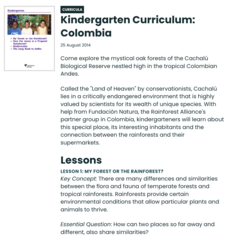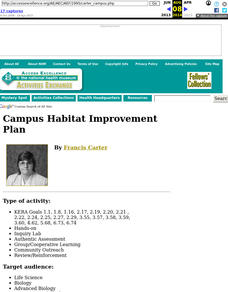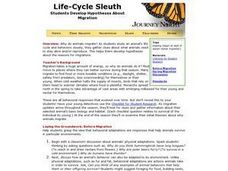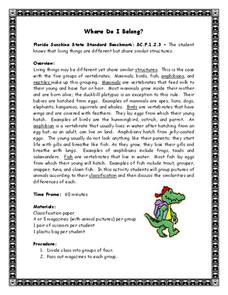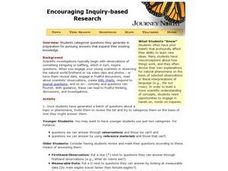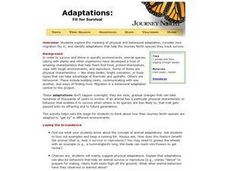Curated OER
My Forest or the Rainforest?
Students explore the flora and fauna of temperate forests and rainforests. They examine the environmental conditions that allow certain plants and animals to live in the rainforest.
Curated OER
Fill The Bill
Students identify and describe five different types of beaks. Using that information, they explain how each of them is adapted to feed on different foods. In groups, they travel around the room to various stations in order to practice...
Curated OER
For the Birds Crossword Puzzle
In this birds worksheet, students read ten clues that pertain to birds and determine the answer from the word box. Students then use the answers to complete a crossword puzzle.
Curated OER
Creating a Pollinator Garden
Young scholars build a pollination garden. In this pollination activity, students read directions and build a pollinator garden that will produce flowering plants for pollinator organisms to use in pollination of other plants.
Curated OER
For The Birds Challenge
In this bird worksheet, learners complete a set of 10 multiple choice questions about features of birds. A reference web site is given, but no information about birds is contained in worksheet.
Curated OER
Campus Habitat Improvement Plan
Young scholars work to improve a plot of land. They assess the needs of the environment and formulate a plan. They plant trees and gardens, build bird boxes, construct waterholes. etc.
Curated OER
Bird Beaks and Feet
In this bird adaptations worksheet, students look at different bird pictures and determine what the bird eats and where it lives by looking at its beak and feet. Students complete a graphic organizer and 5 short answer questions.
Curated OER
Hibernation and Torpor
In this hibernation learning exercise, students read about the differences between hibernation and torpor. Then students determine how long it takes for an animal to warm up or cool down its body. Students complete 4 short answer questions.
Curated OER
Plants and Animals: Partners in Pollination
Students describe the complementary relationships between pollinators and the plants they pollinate, identify adaptations that flowers have developed to "encourage" pollination, and create and draw their own "designer" flowers.
Curated OER
Life-Cycle Sleuth
Students analyze an animal's life cycle and behaviors, and examine what animals need to stay alive and reproduce. They develop theories and hypotheses about the reasons for migrations, using the Journey North online project.
Curated OER
Where Do I Belong?
Fourth graders work in groups. They are given magazines. Students cut pictures of five mamals, five birds, five reptiles, five amphibians, and five fish. They place the pictures in a plastic bag. Students switch bags. They are explained...
Curated OER
Pollinator Habitats
Students read and discuss background information included with this lesson. They brainstorm the best sources for developing a list of native or migratory pollinators. Students work in groups to design habitats based on information...
Curated OER
Species Charades
Students identify endangered species. In this endangered species instructional activity, the teacher leads a discussion about endangered species, then the class plays a game of charades to pantomime animal behavior.
Curated OER
Bird Buffet
Fifth graders investigate how birds use their beaks. In this agriculture lesson, 5th graders use tools to simulate how birds gather food with their beaks. They then draw conclusions about certain types of beaks and what types of food a...
Curated OER
Parts of the Flower and Pollination
Students review the parts of the plant and recognize the parts that are important for pollination. In this pollination lesson, students illustrate and label the parts of a flower. Students compare different types of flowers.
Curated OER
Animal Facts and Opinions
In this fact and opinion worksheet, students read 20 informative sentences about animals. Students write "fact" or "opinion" for each sentence.
Curated OER
The Birds and the Beaks
Learners explore the adaptations that birds have. In this adaptations lesson students view a video and create a concept map of birds and their adaptive traits.
Curated OER
Life Processes
Students investigate the basic needs of organisms that must be met in order to carry out life processes. They view a variety of organism that are meeting and competing for resources. Students create an Idea Web for the animals shown....
Curated OER
A Walk in the Woods
Eighth graders observe and identify the different levels of the forest. In this forest zones instructional activity students observe, identify and name a variety of forest components and describe how humans impact the forest ecosystem.
Curated OER
If It Smells Good, Is Edible, and Attracts Wildlife, Then It's a Practical Garden
Learners explore landscape design. In this practical gardening lesson, students design landscape plans that call for shrubs, trees, and plants that can be used for aesthetics, cooking, and wildlife.
Curated OER
Encouraging Inquiry-Based Research
Students categorize questions they generate in preparation for pursuing answers that expand their existing knowledge. They create KWL charts and respond to journal questions to enable them to inquire to their fullest capacity.
Curated OER
Adaptations: Fit For Survival
Students track species using the Journey North project. They examine the meaning of physical and behavioral adaptation, migration, and identify adaptations that help the species they track survive.
Curated OER
Building a Dichotomous Key
Students analyze how a dichotomous key helps us explain and identify unknown organisms. They design and construct a dichotomous key, developing a list of three observable characteristics per organism.
Curated OER
Look Up - Birds
Students investigate the concept of birds. They identify five different types of birds and name the characteristics that make them different than other living things. Students also name the different parts of the bird and how they are...
Other popular searches
- Hummingbirds Life Cycle
- Basic Facts on Hummingbirds
- Evolution Hummingbirds
- Co Evolution, Hummingbirds
- Anatomy Hummingbirds
- Birds Hummingbirds
- Migration of Hummingbirds
- "Anatomy Hummingbirds
- Hummingbirds and Parrots
- Co Evolution Hummingbirds


